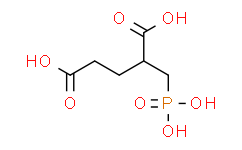| Cas No.: | 173039-10-6 |
| Chemical Name: | PMPA free acid |
| Synonyms: | 2-(Phosphonomethyl)pentanedioic acid;2-(PHOSPHONOMETHYL)PENTANEDIOIC ACID (PMPA);PMPA (NAALADASE INHIBITOR);2-(Phosphonomethyl)-pentandioic acid;2-Phosphonomethyl pentanedioic acid;PMPA;2-PMPA;2-(Phosphonomethyl)pentane-1,5-dioicacid;PMPA(NAALADaseinhibitor);2-(PHOSPHONOMETHYL)-PENTANEDIOIC ACID;2-PMPA(NAALADaseinhibitor);BDBM17659;HMS3267D10;HMS3412K10;HMS3676K10;HMS3749M13;2-Phosphonomethyl-pentanedioic acid;pentanedioic acid analogue, (RS)-1;API0001123;Pentanedioic acid, 2-(phosphonomethyl)-;(R |
| SMILES: | OC(CCC(CP(=O)(O)O)C(=O)O)=O |
| Formula: | C6H11O7P |
| M.Wt: | 226.12 |
| Sotrage: | 2 years -20°C Powder, 2 weeks 4°C in DMSO, 6 months -80°C in DMSO |
| Description: | 2-PMPA is a potent and selective inhibitor of glutamate carboxypeptidase II (GCPII) with an IC50 of 300 pM. |
| In Vivo: | Intraperitoneal administration of 100 mg/kg 2-PMPA results in maximum concentration in plasma of 275 μg/mL at 0.25 h. The half-life, area under the curve, apparent clearance, and volume of distribution are 0.64 h, 210 μg×h/mL, 7.93 mL/min/kg, and 0.44 L/kg, respectively[1]. 2-PMPA at 250 mg/kg, in an anesthetized mouse, after an initial rise, produces a rapid decline and a striking attenuation in BOLD signals in gray matter. The signature of 2-PMPA on brain T2* signals in gray matter at both 167 and 250 mg/kg includes a significant initial rise lasting several minutes[3]. 2-PMPA has neuroprotective activity in an animal model of stroke and anti-allodynic activity in CCI model. Administration of 2-PMPA (50mg/kg) produces a mean peak concentration of 2-PMPA of 29.66±8.1 μM. This concentration is about 100,000 fold more than is needed for inhibition of NAAG peptidase, and indicates very good penetration to the brain. Administration of 50 mg/kg 2-PMPA (i.p.) produces a continuously increasing extracellular NAAG concentration, which startes directly after application[4]. |
| In Vitro: | 2-PMPA is a potent and selective inhibitor of GCPII, an enzyme which catabolizes the abundant neuropeptide N-acetyl-aspartyl-glutamate (NAAG) to N-acetylaspartate (NAA) and glutamate. 2-PMPA demonstrates robust efficacy in numerous animal models of neurological disease. 2-PMPA is a highly polar compound with multiple negative charges causing significant challenges for analysis in biological matrices[1]. 2-PMPA reduces ketamine-induced decrease of cell viability and increase of LDH levels in the mixed cultures but not in the neuronal cultures[2]. |

 To enhance service speed and avoid tariff delays, we've opened a US warehouse. All US orders ship directly from our US facility.
To enhance service speed and avoid tariff delays, we've opened a US warehouse. All US orders ship directly from our US facility.




















